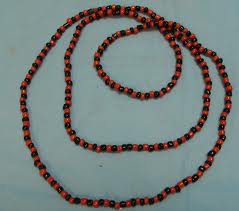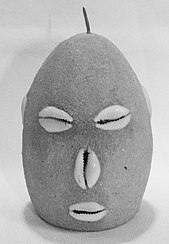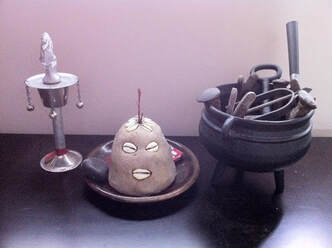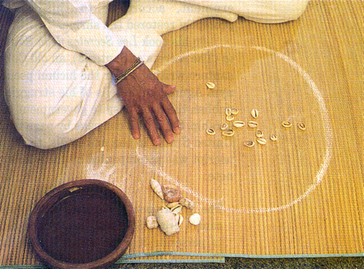Magical Traditions Part 3 Santeria
By
- 9 minutes read - 1782 wordsBooks/Sites Used in this article.
- Magic In The Shadows
- SR3 Core
- aboutsanteria.com - Vocab For Santeria
- Images are used from Creative Common Licenses.
As we forge ahead in new paths of magic in the world we come to another tradition that fall outside of the UCAS and CAS control for the majority of their practitioners. Yoruba in this cases. This faith has similar bone structures of Voodoo and Palo Mayombe. With powerful spirits being called to in order to effect change and offerings to be left and honor to be given.
We will do our best to cover Santeria/Lukumi (Which is a massive subject, so we will get deeper than what MiTS was able to do, but definitely cannot give us the justice it deserves) in hopes to help make the world just a bit more magical and a bit more interesting. Verity is what makes Shadowrun interesting. When everyone is the same, the mystery is dead. Let’s keep that spark alive!
Santeria / Lukumi
Overview of Beliefs
This faith and tradition goes back to Yoruba and has a massive following there. Practitioners gather in homes and traditional “Houses” which is kind of like a church group. They practice together, protect one another and offer aid when someone needs it. They also open the house to newcomers if anyone wishes to practice with them during special events (Often on the “Birthdays” of Orisha. Specifically, Obatalá’s birthday is often used to hold “open houses” where people can come and eat, sing, dance and celebrate with the house.
Lukumi is similar to the other African Traditional Religions (ATRs for short) in that they believe in a single creator deity (named Olodumare) and powerful spirits which the creator had created in order to help run the world they manifested. These spirits are called Orishas and each person is born with a specific Orisha that “owns their head” (Which is kind of like having been born under them, its similar in idea to being born to a totem in Shadowrun’s Shaman system.) Finding out who owns your head and how you can be more spiritually connected to them and the other Orishas is the practitioner’s journey. An interesting aspect of this faith as well is how tied it is to the Roman Catholic Church. As most Casa’s require baptized member before any steps forward can be taken.
Ancestor veneration is another large part of the practice. Often practitioners will have a “white table” setup with glasses of water (To cool the dead) as well as salt and other offers laid out for their ancestors. This table is attended and candles lit for those who have passed before you in order to ask for their guidance and protection. These are called “Eggun”.
Patakis (proverbs) are also heavily used within the tradition. Divination is often used to call upon specific stories that lend some understanding to the situation at hand. These proverbs are orally handed down and are to be memorized for each of the life lessons they offer.
Aché or a kind of mystical power given to the universe by God is how I believe magic would be discussed in Shadowrun from this practices perspective. Those who can use true magic would consider to have a great deal of extra Aché that they are able to work such magics. Aché also has this interesting aspect to it that it cannot be “destroyed”. Instead is manifests and changes then moves onto another. The amount of Aché in the universe cannot change, just where it is can.
Ebbo is an offering made in order to either please your Eggun or an Orisha. It is something given often to help in removing misfortune or the likes. It is usually done through simple offerings such as: leaving cigars at a crossroads at night, offering rum to your Eggun on your white table for a week, or donating time to a shelter. All of these are offerings of either materials, time or energy to something greater than yourself in order to show that you do not need misfortune in order to harden your spirit. Misfortunes are not just random, they build character and are to help us grow. These misfortunates are called “Osorbo”.
Priests of the faith are responsible for helping their folk achieve this connection through various initiatory rites. These rites differ from house to house but most of them contain 3 of the following styles of rites.
Necklaces, Warriors and Crowning.
Receiving your necklaces is generally the first thing you do and is why you often see pictures of Santeria’ priests and priestess wearing so many colorful beaded necklaces. These are called “Elekes” and in Shadowrun would be considered fetishes for being able to cast spells pertaining to different Orishas. Some are also considered to be warders of evil (People found wearing Shango’s Elekes are sometimes passed over when random acts of theft and violence is considered as many don’t wish to bring harm to those being watched over by the Orisha and Fire and Steel.)

Undergoing the rite of the warriors is a much larger step into the world of the Orisha’s as it births a vessel for a spirit to live within. These warriors are often made from clay and stone with cowry shells for eyes and mouths. There are other more complicated statues including those with bells that have life breathed into them during the ceremony. These are placed at the home and once more are used to protect the home and the keepers. It is said that the bells will ring to bring warning to those whom possess the warriors. We will talk a bit more about these later in our special consideration chapter.


Finally, the Crowning is done when you have the Orisha who owns your head brought fully into your life. This act is not always reached by practitioners of the faith because it’s a step in becoming a priest or priestess. Before this is done it is customary for the practitioner to wear only white (and a head dress) for 1 year to prove their devotion and prepared themselves spiritually. For our purposes, I think everyone who can use magic in Shadowrun of this tradition would have had this step completed or it should be their very first initiation act. Once this is done you will be taught how to read the Obi (Which are polished coconut shells) and allowed to throw them for divinatory purposes. A more advanced form of divination is also something that is on the table called dilogún. These are cowry shells that have been blessed and are cast and then read based on the pattern they fall in and how many land up right or down.

Animal Sacrifice
It is hard to talk about Santeria (As it was with Voodoo) without broaching this topic. Animals are given to the Orisha when it is called for by tradition or Obi readings. The animal is killed humanely (in consideration of any animal being killed in any other setting). The blood and offal are given to the Orisha and the meat is given to the people. So it is not unlike a farm to table situation. The animals most often offered are chickens, but goats and other larger animals are not unknown. As always the meat is butchered, cooked and offered. As this practice has been outlawed in the UCAS, I would say this practice would have died out due to those restrictions and upon the return of magic, speaking to Orisha has become infinitely easier. So this may be something done in the past that no longer is needed in the 2060s and beyond.
Place of Worship
Often referred to just as “Casas”, Houses are places of worship. In the UCAS local temples would be less common than in the Caribbean League. So most people would head over to someone’s actual home in order to help clean, cleanse and prepare it for worship. This is often the eldest priest’s home which is made open. White clothes and clothing would be prepared for this and everyone involved should bring a head covering (of white!) to take part in the tradition. It is also customary to bring money, food, and other offerings for both the host and the Orisha to be left on their altar.
Special Rules for running this Tradition
I believe the most interesting way of playing someone under this tradition is to ensure they are a part of a Casa and to have them play their way through the different initiations and progression until they become a full priest. Here is how I would suggest the progression proceed. As well I think this would be an awesome way for a player who isn’t going to start out magical, hear a calling from the Orishas and respond to it. Stories in Shadowrun are POWERFUL when the protagonist hears the call during the course of game play.
I will give an example of that after laying out how I believe the rest should work.
A Santeria priest or priestess should choose an Orisha as they would a Loa in voodoo. This spirit is to be their guiding spirit and they would be able to conjure these spirits as Loa (as it is explained in Magic in the Shadows, Street Grimoire, Street Wyrd ). This would work normally under these traditional guidelines.
I believe once the practitioner has been given their necklaces, these would function under the rules of fetish based magically spells. Each fetish should be chosen for the Orisha in question. So to throw a lightning bolt for instance, Shango’s necklace would be held and prayed with.
Once the warriors have been given. The practitioner should be able to have permanent watcher spirits placed within them. They should give warning to the practitioner whenever an astral body, ritual spell or spirit comes within magic meters of the home or within it. This should function as a watcher spirit that reappears at dawn if banished every day and only stop functioning if physically destroyed. They should have a rating equal to the magic rating of the practitioner and grow in power as they gain more magic.
Finally, once the practitioner has been crowned (which should be an initiation of its own) the practitioner should learn divination during the initiation. This would allow them to throw Obi for those who are in need of it and will be often called upon who are in need of guidance and who are in need of healing. Becoming a priest or priestess makes one a part of a society. That society should call on them for healing and in need at least once a week.